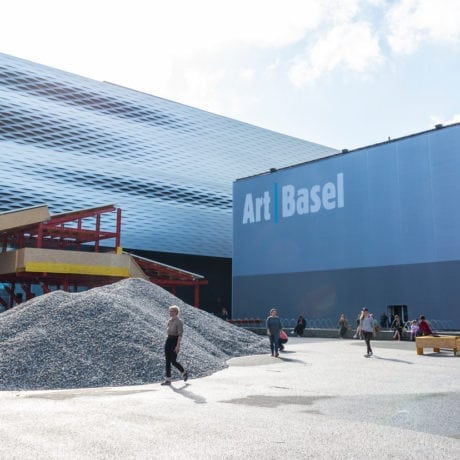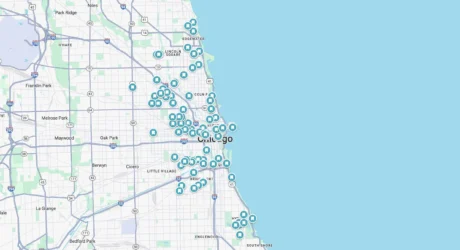
You can call it Stockholm syndrome steeped in FOMO culture—or whatever else you want—but there is an undeniable nihilism (bordering on masochism) to voluntarily attending an art fair. Working your way up the food chain to Art Basel, the symptoms intensify to a point where time and space dissolve, constructs of reality collapse and you find yourself disassociating in a booth far away from everyone you know and getting really emotional about a supersized egg crate made of 24-karat gold.
As a parallel universe of champagne breakfasts, private jet demos, and casual deals often exceeding the million-dollar mark, Art Basel is profoundly taxing on our mental and physical health and a total assault on the senses. If it’s not the immediate regret in footwear choices or the panic of accidentally stepping in the same booth twice (and having to pretend to be interested in the boring art you blitzed through before) that eats away at your will to live, it’s the slowburn effect of the multi-level forest of fluorescent light combined with continuous straining to read wall text that is forever too small. It’s something of a relief, then, that so much of the work displayed at the 2018 edition of Art Basel seemed to deal with precisely this condition.

Stumbling into Jon Rafman’s video installation in Unlimited—Art Basel’s exhibition platform for projects that don’t fit the traditional art-show stand—on the first day gave me the first prickle of mania-induced relief. Being relatively fresh-faced (save for an aggressively delayed budget European flight), I didn’t know what had hit me. Rafman’s bizarrely butchered Dream Journal 2016-2017
offers misplaced grunts superimposed on tragicomic, buffed out glitching figures that seemed both primordial and superhuman at the same time. It is seemingly designed to be seen in a permanent state of jetlag or hangover and is utterly captivating in a paralyzing sort of way. It’s like watching laundry spin or getting a manicure (the violent thump and whirr of machine or the noxious scent of chemicals burning into your brain, mingling with casual time-to-kill pretension).
I looked around at the zoned-out zombie crowd the work had attracted—the precise lifelessness on some faces enough to suggest they had been stuck in this time warp since Tuesday. I hardly realized it at the time, but Rafman would serve as my home base over the next twenty-four hours at Art Basel, its existentially-troubled Laguna beach cavemen becoming fellow comrades in the emotional and physical belligerence of the fair.
“As a parallel universe of champagne breakfasts, private jet demos, and casual deals often exceeding the million-dollar mark, Art Basel is profoundly taxing on our mental and physical health”
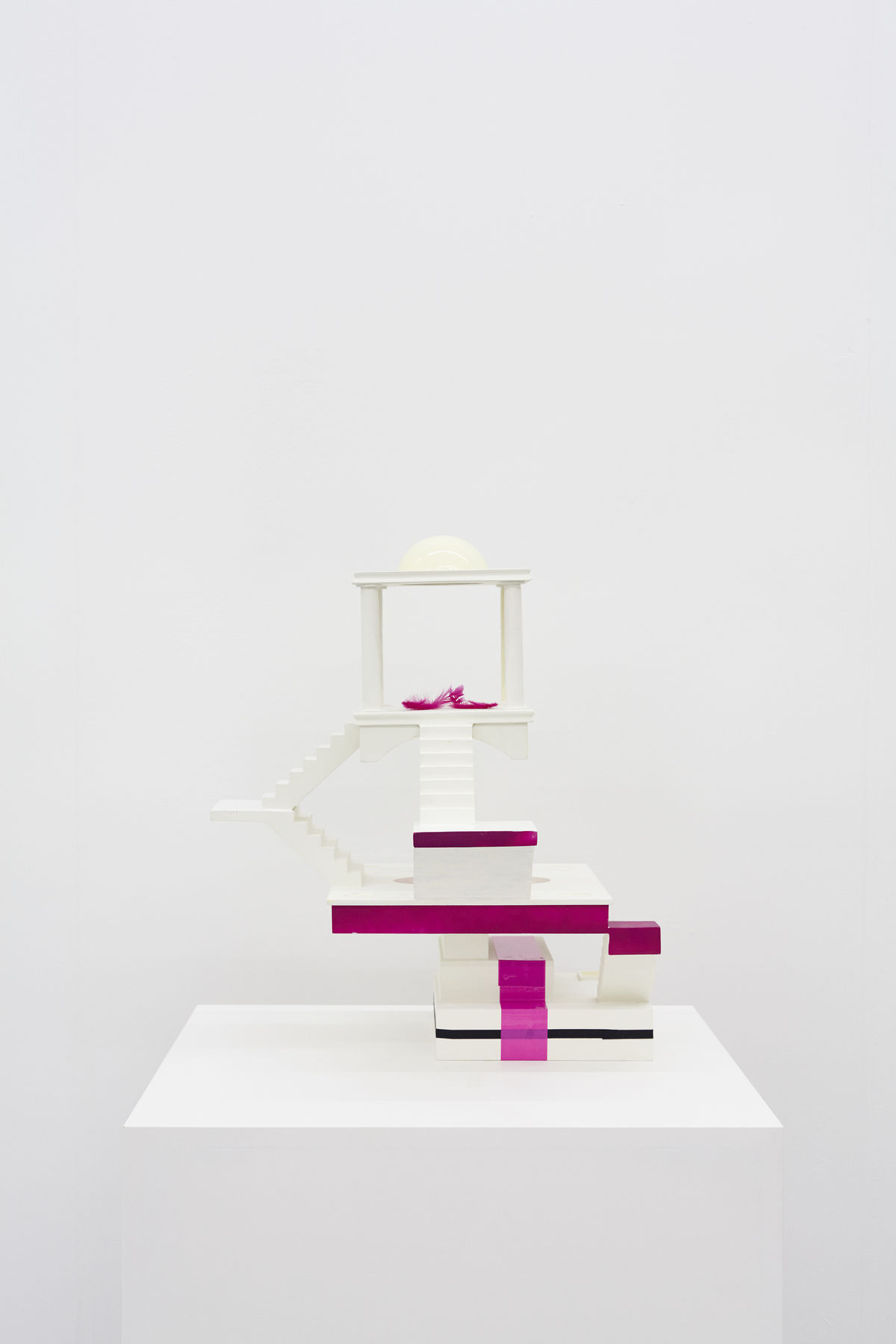
Next, I’m breezing into Liste—Art Basel’s designated space for young blood—I was pleasantly surprised to find the LA-based artist Victoria Colmegna’s work at Park View/Paul Soto: a gallery likewise hailing from the City of Dreams. A series of model spas, named after the artist and retailing for €7,000 a pop, was on offer. Each model waxed poetic on some exotic, 200-year-old historical spa in South America, also available for the low, low cost of nearly $3 million. While some models were made from wood and metal, with giant, treehouse-like extensions and dangling chains that gave off a total steampunk vibe, others had a pared-back minimalism and colour-pop of perspex inserts that felt very, very LA.
I began to understand the beauty in the artifice. We can be anything you want us to be, the Colomegna Spas seemed to suggest, their polished surfaces as slick as any sales pitch. The artist’s fantasy seemed to convey the same enthusiastic and slightly sinister entrepreneurialism at work across the fair at large. It’s all smoke and mirrors—or hot air and private spas.
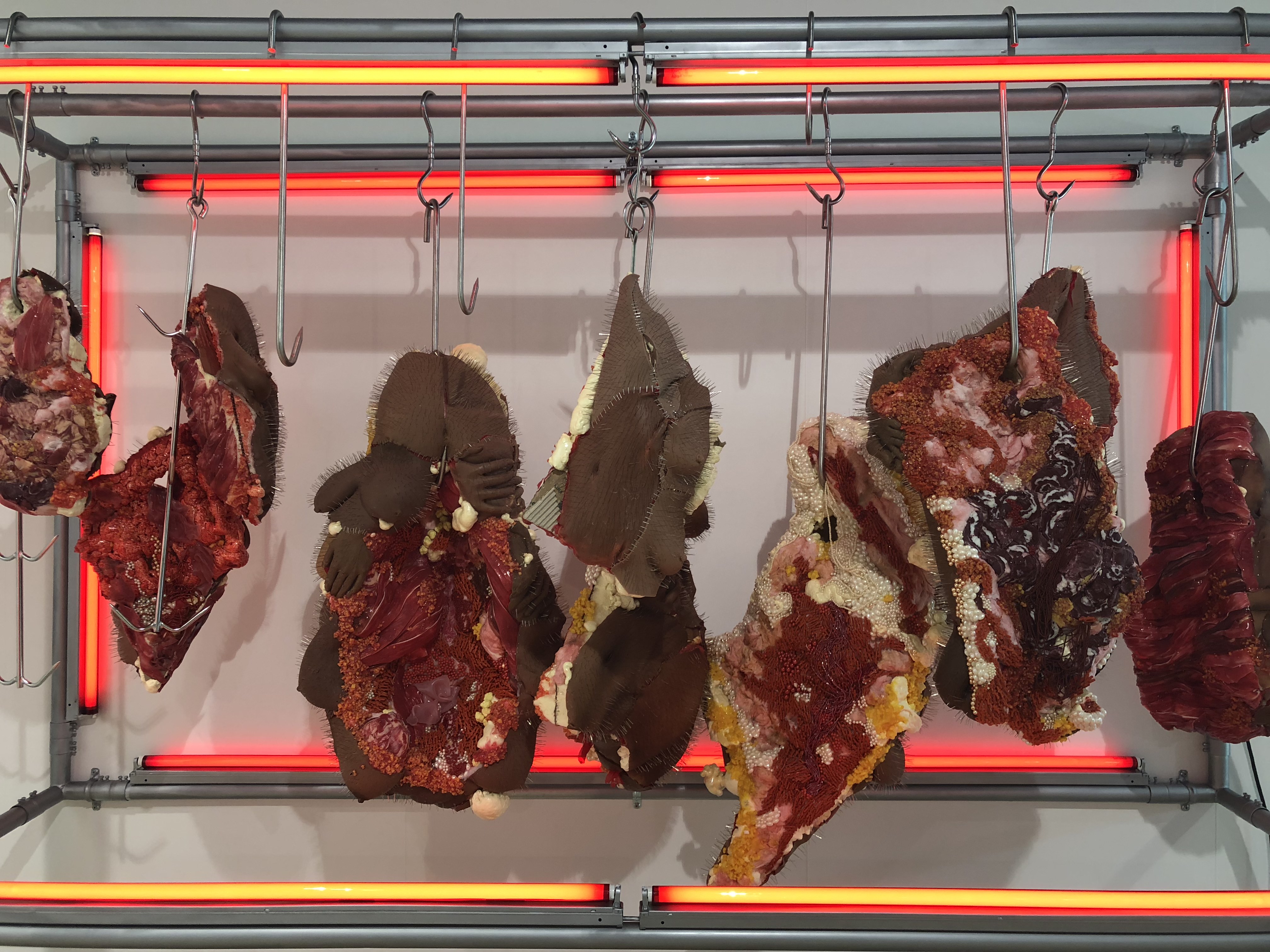
It’s the newcomers to Art Basel that seem the most sceptical of its surreal state of hyper-capitalism and preference for the photogenic over the political. Within the hotly anticipated Statements section, we get a much-needed interlude from the hype and boredom of the infinite booths: with eighteen solo projects by emerging artists that tackle issues of politics, race, culture, and society. A standout is Red Rack of Those Ravaged and Unconsenting by Doreen Garner in the JTT booth. It a powerful mixed-media installation that comments on the brutal medical experiments performed on women of colour in the nineteenth century and onwards. Thick slabs of cast silicone body parts—their interiors decorated with beads, pearls, and fibreglass—are hung from butcher’s hooks, glowing in red fluorescent lights that drown out the buzz of the fair and creates a space for contemplation of that which matters.
“I looked around at the zoned-out zombie crowd the work had attracted—the precise lifelessness on some faces enough to suggest they had been stuck in this time warp since Tuesday”
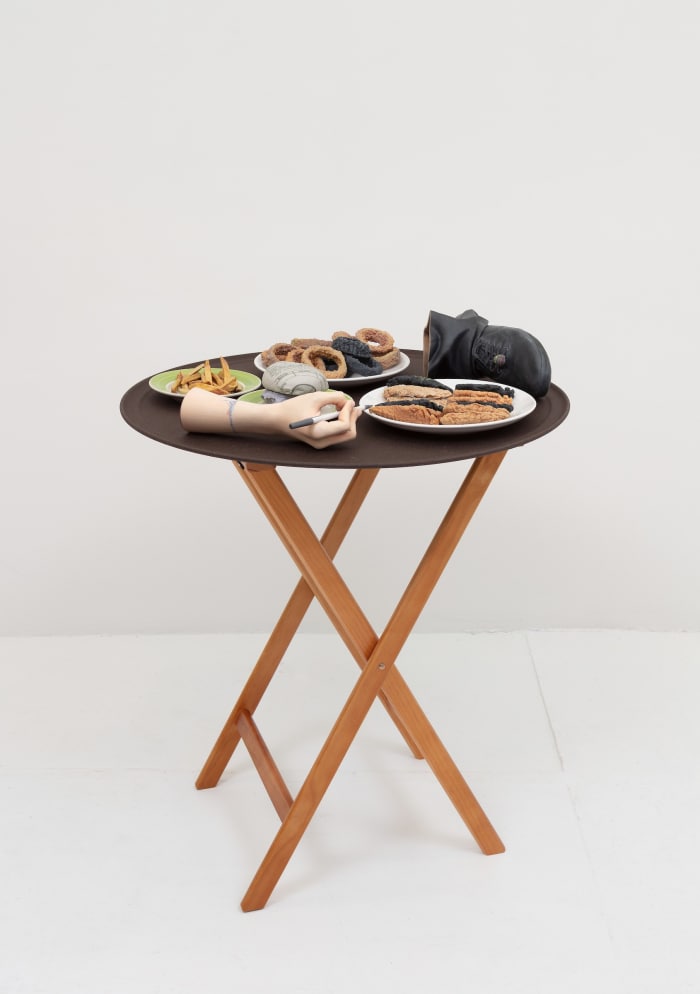
Josh Kline, 10% Tip (Applebee’s Waitress’ Hand and Foot), 2018, with 47 Canal.
Finally arriving at the main drag of Art Basel, the 227-booth expanse has some fresh faces. The New York-based 47 Canal is one of the ten galleries that has “graduated” this year to the big leagues. Thankfully, its critical edge remains healthy, with a new series of work by American artist and curator Josh Kline that riffs off of camp Americana and roadside diner aesthetics. Digging deeper, Kline’s work is a brutal affront on the service industry: a world of night-shifts and America’s tip-based wage system where waiters risk their mental and physical health to make ends meet. Surrounded by the decadence and excess of Art Basel, Kline’s work is especially well-done.
Known for its sharp roster of artists and collectives that blend aesthetics and social criticism, Berlin’s Kraupa-Tuskany Zeidler gallery is showing Anna Uddenberg’s gloriously titled Disconnect (airplane mode). A languid mannequin decked out in a suede tracksuit stretches out on an equally fuzzy furniture object. Her hair covers her face and a puke-green croc dangles off one foot, while the other has been seductively removed and rests atop the lounger. She contorts her body in pin-up fashion while the absurdity of the scene offsets any attempt at seriousness. As I look around at a sea of people staring at their phones, Disconnect seems to coax us with an impossible scenario.
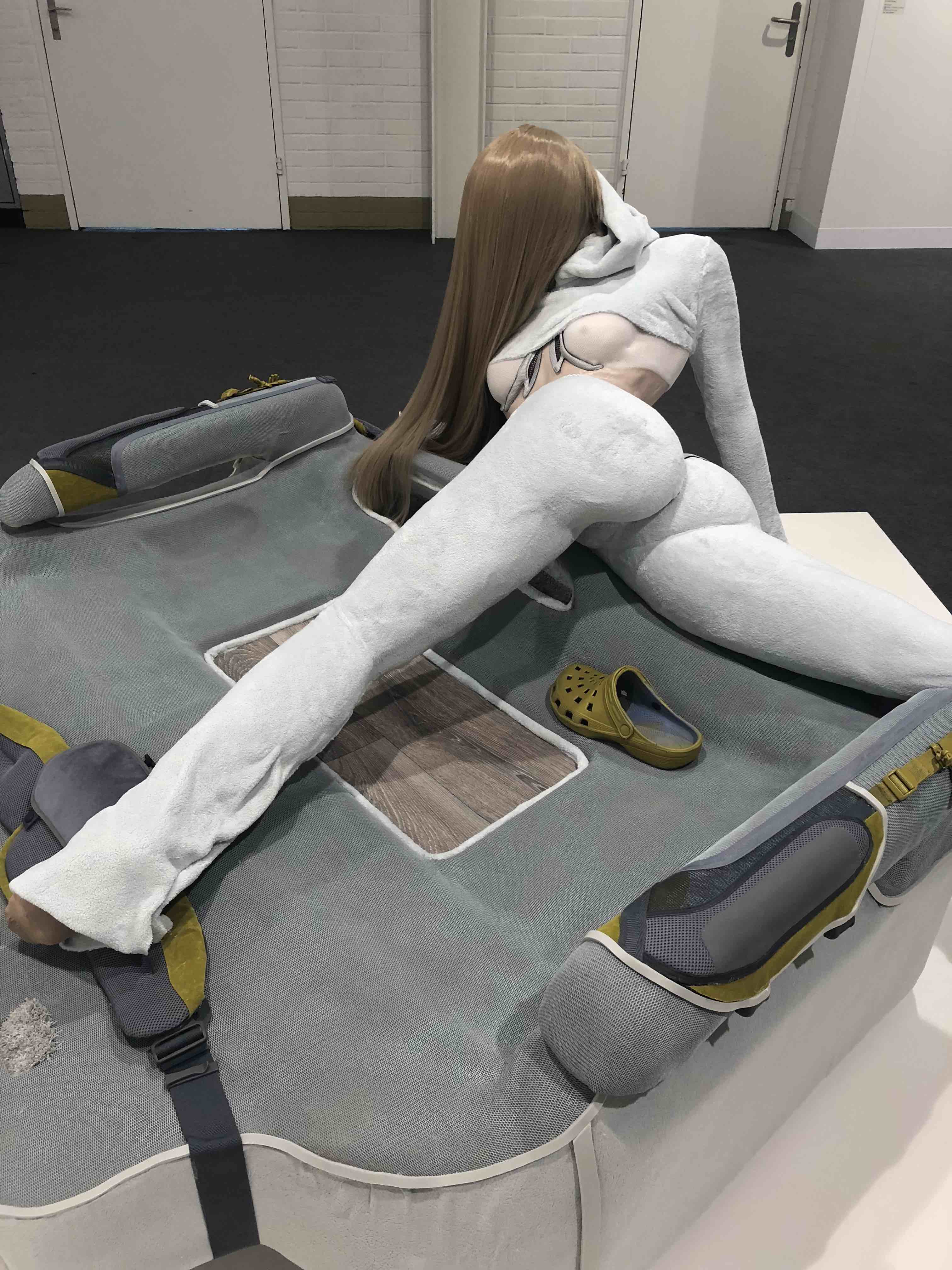
We are all Ron Terada. Or perhaps more appropriately, Ron Terada is all of us. One of the most popular booths in this year’s fair, Catriona Jeffries’s polite white box has been plastered with a series of wall texts by the Vancouver-based Terarda, as part of the artist’s TL;DR series from 2017-8. Across two walls, ominous headlines in the iconic New York Times digital font play out: “Disney Sued for Allegedly Spying on Children Through 42 Gaming Apps” and “Its now impossible to live your best life without subidizing silicon valley” are two of the sinister scenarios seemingly backed up by upper-echelon journalistic street cred. Terada has transplanted stories from tech outlet the Verge into NYT iconicity to command our attention—and underscore the reality of its deficit—with this installation—titled after the chatspeak abbreviation of “too long; didn’t read”.
Respite comes in small doses across the sprawling expanse of Art Basel, where this year’s artists and gallerists seemed to have clued in to the fair’s affront on our mental and physical sanity. No doubt fuelled on in equal part by the increasingly blurred line between fact and fiction in contemporary politics, it promises to be a more frequent feature, as a coup for both sales figures and those in attendance. Do we belong to the hype, or does the hype belong to us? There’s no way of telling, but Art Basel is making a killing by selling our angst back to us. Love thy captor.
